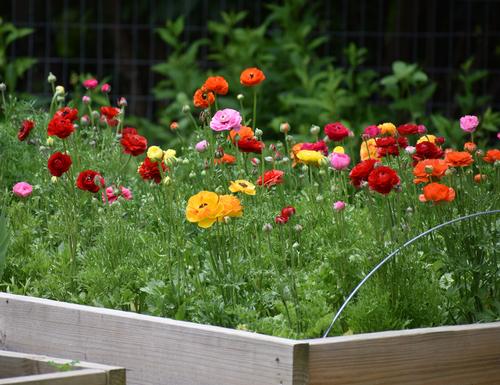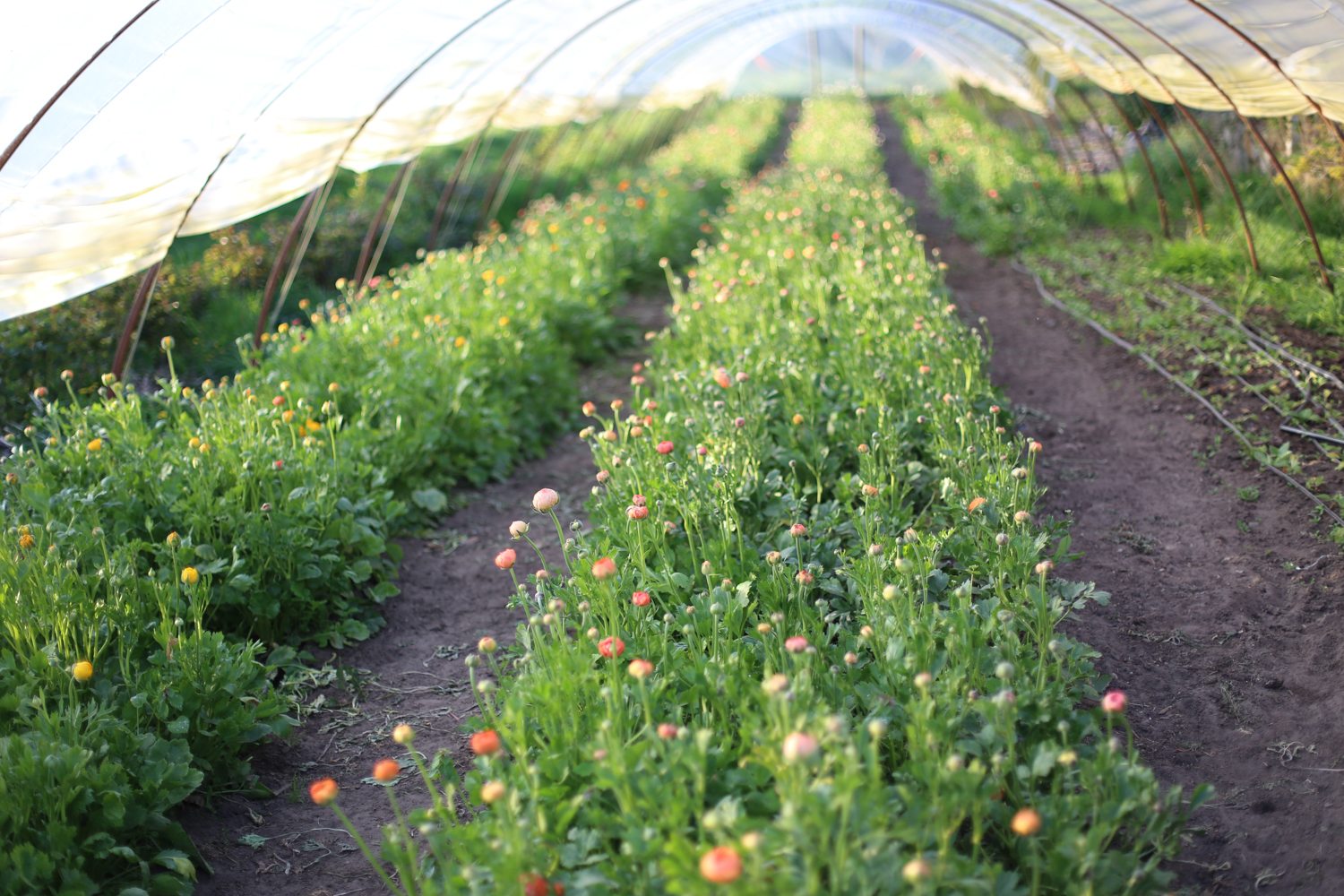To grow ranunculus, plant the bulbs in well-drained soil with full sun exposure. Water regularly and ensure good air circulation.
Ranunculus flowers are a favorite among gardeners for their vibrant colors and lush, layered petals. These beautiful blooms thrive in well-drained soil and sunny spots, making them ideal for a variety of garden settings. Planting ranunculus bulbs in the fall allows them to establish roots before winter.
Regular watering and good air circulation are crucial for healthy growth. With proper care, ranunculus plants will reward you with stunning flowers in the spring. These resilient plants also make excellent cut flowers, adding a touch of elegance to any indoor arrangement. Enjoy the beauty of ranunculus by following these simple growing tips.
:strip_icc()/How-to-Plant-and-Grow-Ranunculus-1499268323-ce1a98aa558740c6988a0627a100dd25.jpg)
Credit: www.bhg.com
Choosing The Right Variety
Choosing the right variety of ranunculus is crucial for a vibrant garden. Ranunculus comes in many types and colors. Each variety has unique traits. Picking the right one can enhance your garden’s beauty.
Popular Ranunculus Types
Some of the most popular ranunculus types include:
- Persian Buttercup: Known for its lush, layered petals.
- Tecolote Giant: These have large, bright blooms.
- Cloni: Famous for their long stems and vibrant colors.
Color And Bloom Preferences
Ranunculus blooms in a variety of colors. They can match any garden theme. Here are some popular color choices:
| Color | Bloom Characteristics |
|---|---|
| White | Elegant and pure, perfect for weddings. |
| Pink | Soft and romantic, ideal for spring gardens. |
| Red | Bold and vibrant, great for eye-catching displays. |
| Yellow | Bright and cheerful, adds sunshine to any space. |
| Orange | Warm and inviting, perfect for autumn displays. |
Consider your garden’s color scheme. Choose ranunculus that complements your existing flowers. Remember, bloom size and stem length also matter. Tecolote Giants have larger blooms. Cloni varieties have longer stems, ideal for cut flowers.
Preparing The Soil
Growing beautiful ranunculus starts with preparing the soil. The right soil ensures healthy plants and vibrant blooms. Follow these steps to create the perfect environment for your ranunculus.
Soil Composition
Ranunculus prefers well-draining soil. Sandy loam is ideal. This type of soil allows water to drain quickly, preventing root rot. You can improve your soil by adding compost or aged manure.
- Ensure the soil is light and airy.
- Mix in organic matter for nutrients.
- Avoid heavy clay soils.
Optimal Ph Levels
Ranunculus thrives in slightly acidic to neutral soil. Aim for a pH between 6.0 and 7.0. You can test your soil using a pH testing kit.
| pH Level | Action Needed |
|---|---|
| Below 6.0 | Add lime to raise pH |
| Above 7.0 | Add sulfur to lower pH |
- Test your soil’s pH.
- Adjust pH if necessary.
- Re-test to ensure optimal levels.
By focusing on soil composition and pH levels, you set the stage for thriving ranunculus. Healthy soil leads to healthy plants and spectacular blooms.
Planting Ranunculus Corms
Planting ranunculus corms is an exciting task for gardeners. These flowers add stunning colors to any garden. Let’s dive into the process.
Timing And Season
Plant ranunculus corms at the right time. The best time is in the fall. This allows the corms to establish roots before winter. In colder regions, plant them in early spring.
Depth And Spacing
Proper depth and spacing are crucial. Plant the corms 2 inches deep. Space them 4-6 inches apart. This ensures healthy growth and beautiful blooms.
| Planting Aspect | Details |
|---|---|
| Depth | 2 inches |
| Spacing | 4-6 inches apart |
By following these simple steps, you can enjoy a vibrant ranunculus garden. Happy planting!

Credit: www.longfield-gardens.com
Watering Techniques
Proper watering techniques are crucial for growing healthy ranunculus. By mastering the right methods, you can ensure your plants thrive. This guide covers the frequency of watering and how to avoid overwatering.
Frequency Of Watering
Water ranunculus plants regularly, but not daily. The soil should stay moist, not soggy. Aim to water every 3-4 days during the growing season. Adjust this based on the weather and soil type.
| Weather Condition | Watering Frequency |
|---|---|
| Hot and Dry | Every 2 days |
| Mild and Humid | Every 4 days |
| Rainy | Once a week |
Avoiding Overwatering
Overwatering is a common mistake that can harm ranunculus. It leads to root rot and fungal diseases. Follow these tips to prevent overwatering:
- Use well-draining soil. This prevents water from pooling.
- Water at the base of the plant, not the leaves.
- Check the soil moisture before watering. If the top inch is dry, it’s time to water.
Using these watering techniques will help your ranunculus flourish. Keep an eye on the weather and adjust your watering schedule as needed. Happy gardening!
Fertilizing For Growth
Fertilizing your ranunculus plants is crucial for their vibrant blooms. Proper fertilization ensures they grow healthy and strong. Let’s dive into the best practices for fertilizing ranunculus.
Best Fertilizer Types
Choosing the right fertilizer is key to thriving ranunculus. Organic fertilizers, like compost or aged manure, are excellent choices. They provide slow-releasing nutrients, improving soil health over time.
For quicker results, balanced fertilizers with equal N-P-K ratios (such as 10-10-10) work well. These fertilizers supply all the essential nutrients ranunculus needs.
| Fertilizer Type | Benefits |
|---|---|
| Organic (Compost, Manure) | Improves soil health, slow nutrient release |
| Balanced (10-10-10) | Quick nutrient supply, balanced growth |
| Bone Meal | Rich in phosphorus, boosts root development |
Application Schedule
Timing is everything for fertilizing ranunculus. Start fertilizing at planting time. Mix compost or aged manure into the soil.
Once shoots appear, apply a balanced fertilizer every 4-6 weeks. This keeps the plants nourished throughout the growing season.
- At planting: Mix organic matter into soil.
- When shoots appear: Apply balanced fertilizer every 4-6 weeks.
- During blooming: Use bone meal to enhance blooms.
Water the plants after fertilizing to help nutrients reach the roots. Avoid over-fertilizing, as it can harm the plants. Stick to the schedule for the best results.
Pest And Disease Control
Ranunculus plants are beautiful but can attract pests and diseases. Learning how to manage these issues is essential for a healthy garden.
Common Pests
Several pests can harm Ranunculus plants. Here are the most common ones:
- Aphids: Small insects that suck plant sap.
- Spider Mites: Tiny arachnids causing yellow spots on leaves.
- Thrips: Insects that damage flowers and leaves.
- Slugs and Snails: Mollusks that chew on leaves and stems.
Preventive Measures
Preventing pests is easier than dealing with an infestation. Follow these steps:
- Inspect plants regularly for signs of pests.
- Use neem oil or insecticidal soap as a natural pesticide.
- Introduce beneficial insects like ladybugs to your garden.
- Keep the garden clean and free of debris.
Common Diseases
Ranunculus plants can suffer from several diseases. The most common ones are:
| Disease | Symptoms |
|---|---|
| Powdery Mildew | White powdery spots on leaves. |
| Botrytis Blight | Gray mold on flowers and stems. |
| Root Rot | Yellow leaves and mushy roots. |
Preventive Measures
Prevent diseases to keep your Ranunculus healthy. Here are some tips:
- Water plants at the base, avoiding the leaves.
- Ensure good air circulation around plants.
- Remove infected leaves and stems immediately.
- Use fungicides as a last resort.
Pruning And Deadheading
Pruning and deadheading are essential for healthy ranunculus plants. These practices encourage more blooms and keep your garden tidy. Let’s explore when to prune and the benefits of deadheading.
When To Prune
Prune ranunculus plants during their growing season. Trim back any dead or damaged stems. Use sharp, clean scissors to make the cuts. Remove any yellow or brown leaves. This helps the plant focus its energy on healthy growth.
Prune the plants in the early morning or late afternoon. Avoid pruning during the hottest part of the day. This reduces stress on the plants. Regular pruning keeps your ranunculus looking its best.
Benefits Of Deadheading
Deadheading is the process of removing spent blooms. This encourages the plant to produce more flowers. It also prevents the plant from wasting energy on seed production.
Deadheading helps maintain a neat and attractive garden. It reduces the risk of disease and pest infestations. Spent blooms can harbor insects and fungi. Removing them keeps your garden healthier.
Follow these steps for effective deadheading:
- Inspect your plants regularly for spent blooms.
- Use sharp scissors to snip off the dead flowers.
- Cut just above the first set of healthy leaves.
By practicing pruning and deadheading, your ranunculus plants will thrive. They will produce more vibrant blooms throughout the season.
Harvesting And Storing Blooms
Ranunculus blooms are stunning and versatile. To enjoy them longer, learn the best practices for harvesting and storing. This ensures you get the most out of your beautiful flowers.
Best Harvesting Practices
When harvesting ranunculus, timing is key. Cut the stems early in the morning. This helps preserve moisture in the blooms. Choose flowers that are just beginning to open. These will last longer in a vase.
Use sharp, clean scissors or shears to avoid damaging the stems. Cut the stems at an angle. This allows better water absorption. Remove any leaves that would be underwater in a vase. Leaves in water can rot and cause bacteria.
- Harvest early in the morning.
- Choose blooms just starting to open.
- Use sharp, clean tools.
- Cut stems at an angle.
- Remove leaves below water level.
Storage Tips
Proper storage keeps your ranunculus fresh longer. After cutting, place the stems in a bucket of clean, cool water. This keeps them hydrated until you arrange them.
Store the bucket in a cool, dark place. Avoid direct sunlight and heat sources. These can cause the flowers to wilt faster. Change the water daily to keep it fresh and clean.
If you need to store blooms for a few days, wrap them in damp paper towels. Place them in a plastic bag in the fridge. This slows down the blooming process.
Here’s a quick table for easy reference:
| Storage Tip | Details |
|---|---|
| Keep in cool water | Place stems in clean, cool water after cutting |
| Store in a cool place | Avoid direct sunlight and heat |
| Change water daily | Fresh water keeps blooms longer |
| Refrigerate if needed | Wrap in damp paper towels and place in fridge |
Following these tips ensures your ranunculus blooms stay fresh and vibrant. Enjoy their beauty for a longer time.

Credit: www.floretflowers.com
Frequently Asked Questions
How Do You Plant Ranunculus Bulbs?
Plant ranunculus bulbs in well-drained soil, about 2 inches deep. Space them 4-6 inches apart. Ensure they get full sunlight for optimal growth.
When Is The Best Time To Plant Ranunculus?
The best time to plant ranunculus is in the fall for spring blooms. In warmer climates, plant in late winter or early spring.
How Often Should I Water Ranunculus?
Water ranunculus thoroughly after planting. Then, water them weekly. Be careful not to overwater, as they prefer slightly dry soil.
Can Ranunculus Grow In Pots?
Yes, ranunculus can grow in pots. Use well-draining soil and ensure the pot has drainage holes. Place in a sunny spot.
Conclusion
Growing ranunculus can be a rewarding experience. Follow the steps outlined to ensure vibrant blooms. Provide adequate sunlight, water, and soil conditions. With patience and care, you will enjoy beautiful flowers in your garden. Happy gardening!
